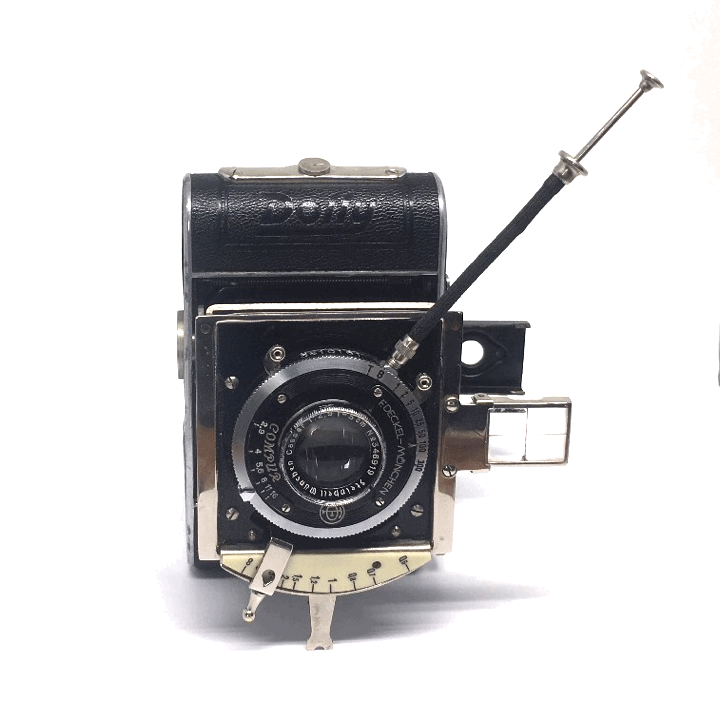
Certo Dolly Modell B
Kameras mit Geschichte sind meine Leidenschaft. Die Dolly Modell B, gebaut in Dresden 1932 mit Komponenten, die in meiner Heimatstadt München hergestellt wurden - einem Deckel-Verschluss und dem Steinheil Cassar-Objektiv - ist so eine Kamera mit Geschichte. Ich habe sie kürzlich von einer netten älteren Dame geschenkt bekommen, deren Vater sie vor dem Zweiten Weltkrieg gekauft und viel damit fotografiert hat. Eine Kamera, die 80 Jahre lang in der selben Familie geblieben ist und jetzt von mir zu neuem Leben erweckt wird.
Die Dolly ist ein typisches Kind ihrer Zeit, der 1930er-Jahre. Eine Kamera, in der Weltwirtschaftskrise auf den Markt gekommen, als sich viele Menschen das damals noch recht teure Hobby der Fotografie nicht mehr leisten konnten. Die Dolly und andere Kameras dieser Ära rangen dem 127er Rollfilm, der ursprünglich für acht Aufnahmen im Format 4x6 cm gedacht war, 16 Bilder im Format 4x3 ab - doppelt so viele Photos für's selbe Geld.
Heute ist der 127er Rollfilm ein vom Aussterben bedrohtes Luxusgut, nur wenige Filmhersteller haben den Mini-Rollfilm noch im Programm und lassen sich das Sonderformat fürstlich bezahlen - über 12 € für einen Film sind ein üblicher Preis. Eigentlich schade, denn der 127er hat durchaus seine Vorteile. Zum Beispiel, dass man für ihn kleinere Kameras bauen kann - beziehungsweise konnte, denn eine moderne 127er Kamera ist mir nicht bekannt. Aber wer jemals eine Baby Rolleiflex für das Format 4x4 (welches als Superdia noch in normale Kleinbild-Diarähmchen passte und deshalb dem 127er in den 1960er Jahren noch einmal eine kurze Blüte bescherte) neben ihre große Schwester gestellt hat, weiß, warum Kodak den 1912 auf den Markt gebrachten Film den Beinamen "Vest Pocket Film" gab.
Gut, die Weste, in deren Tasche eine Baby Rolleiflex passt, dürfte nicht besonders kleidsam sein, aber die Certo Dolly ist eine der kleinsten Kameras, die ich besitze. So gut wie alle meine Kleinbildkameras, selbst meine geliebten Kodak Retinas, sind verglichen mit ihr wahre Riesen, sieht man von der kleinsten von ihnen, der alten Retina I von 1936, einmal ab. Aber auch die - obwohl sie den kleineren 35mm Film verwendet, ist noch ein paar Millimeter länger als die extrem schlanke Dolly. Ich besitze nur eine einzige Kleinbildkamera, die kleiner ist als die Dolly: Die Minox 35.
Certo Dolly Modell B
I love cameras with a personal history. The Dolly Modell B, built 1932 in Dresden with components made in my home town Munich (a Compur shutter and a Steinheil Cassar lens) is such a camera. I got it as a present from a very nice elder lady whose father bought the camera before WW 2 and took a lot of pictures with it. A camera that stayed for 80 years with the same family and is now living a new photographic life in my hands.
The Doll is a typical product of its time. In the 1930ies the Great Depression many amateur photographers could not afford their rather expensive hobby any more. The camera manufacturers reacted and built cameras that were able to get 16 pictures in the format 4x3cm out of the 127 roll film, originally made for eight exposures measuring 4x6cm, thus providing more images for the photographer's hard earned money.
Today the 127 roll film is a luxury good, threatened by extinction. While 135 and 120 films are still produced by a lot of different manufacturers, the 127 is offered only by a few firms that charge a steep extra price for them.
Which is a pity, because the 127 has a couple of substantial benefits. One of them is the fact that it enabled the camera factories to miniaturize their medium format cameras. A good example are the Baby Rolleiflex and the Yashica 44 that had their short heyday in the 1960ies because the 4x4cm slides of the 127 film could be fitted into "normal" 35mm slide frames while providing a lot more picture real estate.
Put a Baby Rolleiflex side by side to its bigger sisters and you know why Kodak nicknamed the 127 when it was introduced 1912 "Vest pocket film".
Okay, the vest pocket accomodating a Baby Rolleiflex still has to be tailored, but my Certo Dolly is one of the smallest cameras i own.
Almost all of my 135mm cameras, including my beloved Kodak Retinas (with the exception of the Retina I from 1936, a contemporary of the Dolly) are substantially bigger than the little Certo although they use the smaller 35mm format. There is only one model amongst my many 135 cameras that beats the Certo Dolly in measurements: The Minox 35.